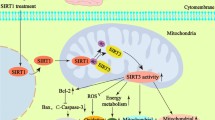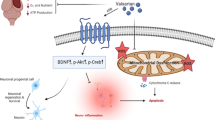Abstract
Background
Rhein, which has antioxidant and anti-inflammatory response properties, is a beneficial treatment for different pathologies. However, the mechanism by which rhein protects against myocardial ischemic injury is poorly understood.
Methods and results
To establish an acute myocardial infarction (AMI) rat model, we performed left anterior descending (LAD) ligation. Sprague‒Dawley rats were randomly divided into four groups: sham, AMI, AMI + rhein (AMI + R), and AMI + mitochondrial fission inhibitor (AMI + M). The extent of myocardial injury was evaluated by TTC staining, serum myocardial injury markers, and HE and Masson staining. Cardiac mitochondria ultrastructure was visualized by transmission electron microscopy. TUNEL assay and flow cytometry analysis were used to estimate cell apoptosis. Protein expression levels were measured by Western blotting. In vitro, the efficacy of rhein was assessed in H9c2 cells under hypoxic condition. Our results revealed that rats with AMI exhibited increased infarct size and indicators of myocardial damage, along with activation of Drp1-dependent mitochondrial fission, decreased mitophagy and increased apoptosis rates. However, pretreatment with rhein significantly reversed these effects and demonstrated similar efficacy to Mdivi-1. Furthermore, rhein pretreatment protected against myocardial ischemic injury by inhibiting mitochondrial fission, as evidenced by decreased Drp1 expression. It also enhanced mitophagy, as indicated by increased expression of Beclin1, Pink1 and Parkin, an increased LC3-II/LC3-I ratio and increased formation of autolysosomes. Additionally, rhein pretreatment mitigated apoptosis in AMI. These results were also confirmed in vitro in H9c2 cells.
Conclusion
Our results demonstrate that rhein pretreatment exerts cardioprotective effects against myocardial ischemic injury via the Drp1/Pink1/Parkin pathway.





Similar content being viewed by others
Data availability
The data that support the findings of this study are available from the corresponding author upon reasonable request.
References
Tsao CW, Aday AW, Almarzooq ZI et al (2022) Heart disease and stroke statistics-2022 update: a report from the American Heart Association. Circulation 145(8):e153–e639. https://doi.org/10.1161/cir.0000000000001052
Andersson C, Vasan RS (2018) Epidemiology of cardiovascular disease in young individuals. Nat Rev Cardiol 15(4):230–240. https://doi.org/10.1038/nrcardio.2017.154
Sawalha K, Norgard N, López-Candales A (2023) Epigenetic regulation and its effects on aging and cardiovascular disease. Cureus 15(5):e39395. https://doi.org/10.7759/cureus.39395
Zhu H, Toan S, Mui D, Zhou H (2021) Mitochondrial quality surveillance as a therapeutic target in myocardial infarction. Acta Physiol (Oxf, Engl) 231(3):e13590. https://doi.org/10.1111/apha.13590
Ramachandra CJA, Hernandez-Resendiz S, Crespo-Avilan GE, Lin YH, Hausenloy DJ (2020) Mitochondria in acute myocardial infarction and cardioprotection. EBioMedicine 57:102884. https://doi.org/10.1016/j.ebiom.2020.102884
Zhou M, Yu Y, Luo X et al (2021) Myocardial ischemia-reperfusion injury: therapeutics from a mitochondria-centric perspective. Cardiology 146(6):781–792. https://doi.org/10.1159/000518879
Xin Y, Zhang X, Li J et al (2021) New insights into the role of mitochondria quality control in ischemic heart disease. Front Cardiovasc Med 8:774619. https://doi.org/10.3389/fcvm.2021.774619
Li A, Gao M, Liu B et al (2022) Mitochondrial autophagy: molecular mechanisms and implications for cardiovascular disease. Cell Death Dis 13(5):444. https://doi.org/10.1038/s41419-022-04906-6
Bai Y, Wu J, Yang Z, Wang X, Zhang D, Ma J (2023) Mitochondrial quality control in cardiac ischemia/reperfusion injury: new insights into mechanisms and implications. Cell Biol Toxicol 39(1):33–51. https://doi.org/10.1007/s10565-022-09716-2
Lin J, Duan J, Wang Q, Xu S, Zhou S, Yao K (2022) Mitochondrial dynamics and mitophagy in cardiometabolic disease. Front Cardiovasc Med 9:917135. https://doi.org/10.3389/fcvm.2022.917135
Zhou H, Ren J, Toan S, Mui D (2021) Role of mitochondrial quality surveillance in myocardial infarction: from bench to bedside. Ageing Res Rev 66:101250. https://doi.org/10.1016/j.arr.2020.101250
Uchikado Y, Ikeda Y, Ohishi M (2022) Current understanding of the pivotal role of mitochondrial dynamics in cardiovascular diseases and senescence. Front Cardiovasc Med 9:905072. https://doi.org/10.3389/fcvm.2022.905072
García-Niño WR, Zazueta C, Buelna-Chontal M, Silva-Palacios A (2021) Mitochondrial quality control in cardiac-conditioning strategies against ischemia-reperfusion injury. Life (Basel, Switzerland). https://doi.org/10.3390/life11111123
Man-Li Z, Yu F, Shu-le Q, Xiao-Xin L, Si-Qi XU, Wei-Xiong J (2020) Research progress on potential targets-mitochondrial dynamics-related proteins in treatment of myocardial ischemia-reperfusion injury. Zhongguo Zhong yao za zhi = Zhongguo zhongyao zazhi 45(17):4183–4195. https://doi.org/10.19540/j.cnki.cjcmm.20200623.602
Turkieh A, El Masri Y, Pinet F, Dubois-Deruy E (2022) Mitophagy regulation following myocardial infarction. Cells 11(2):199. https://doi.org/10.3390/cells11020199
Ajoolabady A, Chiong M, Lavandero S, Klionsky DJ, Ren J (2022) Mitophagy in cardiovascular diseases: molecular mechanisms, pathogenesis, and treatment. Trends Mol Med 28(10):836–849. https://doi.org/10.1016/j.molmed.2022.06.007
Song M, Gong G, Burelle Y et al (2015) Interdependence of Parkin-mediated mitophagy and mitochondrial fission in adult mouse hearts. Circ Res 117(4):346–351. https://doi.org/10.1161/circresaha.117.306859
Hu J, Liu T, Fu F et al (2022) Omentin1 ameliorates myocardial ischemia-induced heart failure via SIRT3/FOXO3a-dependent mitochondrial dynamical homeostasis and mitophagy. J Transl Med 20(1):447. https://doi.org/10.1186/s12967-022-03642-x
Kubli DA, Zhang X, Lee Y et al (2013) Parkin protein deficiency exacerbates cardiac injury and reduces survival following myocardial infarction. J Biol Chem 288(2):915–926. https://doi.org/10.1074/jbc.M112.411363
Lutz AK, Exner N, Fett ME et al (2009) Loss of Parkin or PINK1 function increases Drp1-dependent mitochondrial fragmentation. J Biol Chem 284(34):22938–22951. https://doi.org/10.1074/jbc.M109.035774
Fang X, Gustafsson ÅB (2023) DRP1-mediated mitophagy: safeguarding obese hearts from cardiomyopathy. Circ Res 133(1):22–24. https://doi.org/10.1161/circresaha.123.323013
Tong M, Mukai R, Mareedu S et al (2023) Distinct roles of DRP1 in conventional and alternative mitophagy in obesity cardiomyopathy. Circ Res 133(1):6–21. https://doi.org/10.1161/circresaha.123.322512
Li GM, Chen JR, Zhang HQ et al (2021) Update on pharmacological activities, security, and pharmacokinetics of rhein. Evid Based ComplementAltern Med 2021:4582412. https://doi.org/10.1155/2021/4582412
Zhang D, Wu H, Liu D, Li YZ, Zhou G (2022) Research progress on the mechanism and treatment of inflammatory response in myocardial ischemia-reperfusion injury. Heart Surg Forum 25(3):E462–E468. https://doi.org/10.1532/hsf.4725
Liu J, Chen Z, Zhang Y et al (2013) Rhein protects pancreatic β-cells from dynamin-related protein-1-mediated mitochondrial fission and cell apoptosis under hyperglycemia. Diabetes 62(11):3927–3935. https://doi.org/10.2337/db13-0251
Liu J, Li Y, Tang Y et al (2018) Rhein protects the myocardiac cells against hypoxia/reoxygention-induced injury by suppressing GSK3β activity. Phytomedicine 51:1–6. https://doi.org/10.1016/j.phymed.2018.06.029
Barbosa D, Fahlbusch P, Herzfeld de Wiza D et al (2020) Rhein, a novel histone deacetylase (HDAC) inhibitor with antifibrotic potency in human myocardial fibrosis. Sci Rep 10(1):4888. https://doi.org/10.1038/s41598-020-61886-3
Lu W, Zhu H, Wu J, Liao S, Cheng G, Li X (2022) Rhein attenuates angiotensin II-induced cardiac remodeling by modulating AMPK-FGF23 signaling. J Transl Med 20(1):305. https://doi.org/10.1186/s12967-022-03482-9
Li RJ, Xu JJ, Zhang ZH et al (2022) Rhein ameliorates transverse aortic constriction-induced cardiac hypertrophy via regulating STAT3 and p38 MAPK signaling pathways. Front Pharmacol 13:940574. https://doi.org/10.3389/fphar.2022.940574
Han B, Cao G, Jia L et al (2022) Cardioprotective effects of tetrahydropalmatine on acute myocardial infarction in rats. Am J Chin Med 50(7):1887–1904. https://doi.org/10.1142/s0192415x2250080x
Ma B, Guo B, Chen Z, Li Y (2022) SIRT1 regulates hypoxia-induced oxidative stress in cardiomyocytes via PI3K/MTOR signaling. Cell Mol Biol (Noisy-le-Grand, France) 68(2):48–53. https://doi.org/10.14715/cmb/2022.68.2.7
Jiang H, Tang W, Song Y, Jin W, Du Q (2022) Induction of apoptosis by metabolites of Rhei Radix et Rhizoma (Da Huang): a review of the potential mechanism in hepatocellular carcinoma. Front Pharmacol 13:806175. https://doi.org/10.3389/fphar.2022.806175
Chang X, Liu R, Li R, Peng Y, Zhu P, Zhou H (2023) Molecular mechanisms of mitochondrial quality control in ischemic cardiomyopathy. Int J Biol Sci 19(2):426–448. https://doi.org/10.7150/ijbs.76223
Jin JY, Wei XX, Zhi XL, Wang XH, Meng D (2021) Drp1-dependent mitochondrial fission in cardiovascular disease. Acta Pharmacol Sin 42(5):655–664. https://doi.org/10.1038/s41401-020-00518-y
Scheffer DDL, Garcia AA, Lee L, Mochly-Rosen D, Ferreira JCB (2022) Mitochondrial fusion, fission, and mitophagy in cardiac diseases: challenges and therapeutic opportunities. Antioxid Redox Signal 36(13–15):844–863. https://doi.org/10.1089/ars.2021.0145
Ding J, Zhang Z, Li S et al (2022) Mdivi-1 alleviates cardiac fibrosis post myocardial infarction at infarcted border zone, possibly via inhibition of Drp1-activated mitochondrial fission and oxidative stress. Arch Biochem Biophys 718:109147. https://doi.org/10.1016/j.abb.2022.109147
Mokhtari B, Badalzadeh R (2022) Protective and deleterious effects of autophagy in the setting of myocardial ischemia/reperfusion injury: an overview. Mol Biol Rep 49(11):11081–11099. https://doi.org/10.1007/s11033-022-07837-9
Pedriali G, Ramaccini D, Bouhamida E et al (2022) Perspectives on mitochondrial relevance in cardiac ischemia/reperfusion injury. Front Cell Dev Biol 10:1082095. https://doi.org/10.3389/fcell.2022.1082095
Xia JY, Chen C, Lin Q et al (2023) Role of mitophagy in myocardial ischemia/reperfusion injury and Chinese medicine treatment. Chin J Integr Med 29(1):81–88. https://doi.org/10.1007/s11655-021-3301-1
Cheng J, Ji M, Jing H, Lin H (2023) DUSP12 ameliorates myocardial ischemia-reperfusion injury through HSPB8-induced mitophagy. J Biochem Mol Toxicol 37(5):e23310. https://doi.org/10.1002/jbt.23310
Qiu F, Yuan Y, Luo W et al (2022) Asiatic acid alleviates ischemic myocardial injury in mice by modulating mitophagy- and glycophagy-based energy metabolism. Acta Pharmacol Sin 43(6):1395–1407. https://doi.org/10.1038/s41401-021-00763-9
Fu T, Ma Y, Li Y, Wang Y, Wang Q, Tong Y (2023) Mitophagy as a mitochondrial quality control mechanism in myocardial ischemic stress: from bench to bedside. Cell Stress Chaperones 28(3):239–251. https://doi.org/10.1007/s12192-023-01346-9
Teringova E, Tousek P (2017) Apoptosis in ischemic heart disease. J Transl Med 15(1):87. https://doi.org/10.1186/s12967-017-1191-y
Acknowledgements
We sincerely thank all the colleagues from the National Clinical Research Center of Kidney Diseases in Jinling Hospital for their invaluable assistance and guidance in our experimental techniques. In particular, we thank our colleagues who participated in this study.
Funding
The present study was supported by the National Natural Science Foundation of China (Grant Number 81400238) and Basic Research Programs of Jinling Hospital, China (Grant Number 22JCYYYB46).
Author information
Authors and Affiliations
Contributions
JL, LW, MG and HL conceptualized and participated in the overall design, supervision and coordination of the study. HL, YJ and DY designed and performed most of the experiments. The first draft of the manuscript was written by HL and all authors commented on previous versions of the manuscript. LW revised of the manuscript. All the authors have read and approved the final manuscript.
Corresponding authors
Ethics declarations
Competing interests
The authors have no relevant financial or nonfinancial interests to declare.
Ethical approval
Our study was carried out as per recommendations from the Animal Ethical Committee of Jinling Hospital (Approval No. 2021DZGKJDWLS-0042) strictly following the guidelines of National Institutes of Health (NIH) for the Care and Use of Laboratory Animals.
Additional information
Publisher's Note
Springer Nature remains neutral with regard to jurisdictional claims in published maps and institutional affiliations.
Supplementary Information
Below is the link to the electronic supplementary material.
Rights and permissions
Springer Nature or its licensor (e.g. a society or other partner) holds exclusive rights to this article under a publishing agreement with the author(s) or other rightsholder(s); author self-archiving of the accepted manuscript version of this article is solely governed by the terms of such publishing agreement and applicable law.
About this article
Cite this article
Li, H., Jia, Y., Yao, D. et al. Rhein alleviates myocardial ischemic injury by inhibiting mitochondrial division, activating mitochondrial autophagy and suppressing myocardial cell apoptosis through the Drp1/Pink1/Parkin pathway. Mol Biol Rep 51, 266 (2024). https://doi.org/10.1007/s11033-023-09154-1
Received:
Accepted:
Published:
DOI: https://doi.org/10.1007/s11033-023-09154-1




